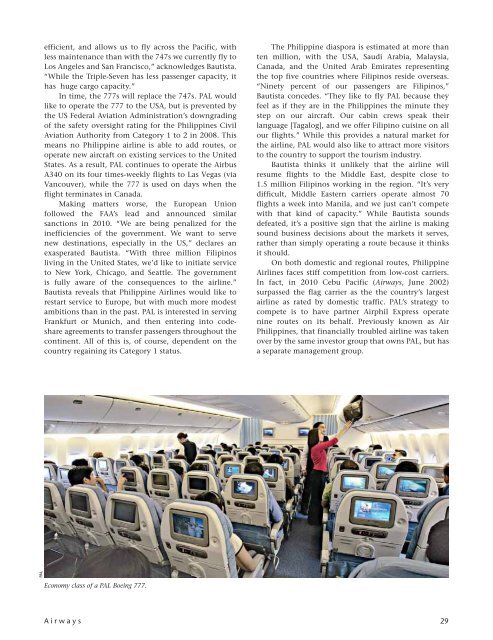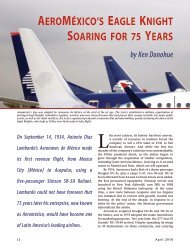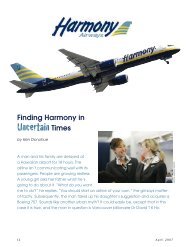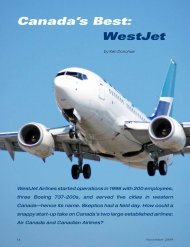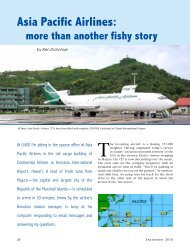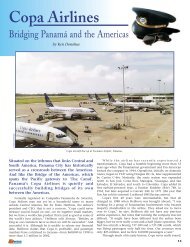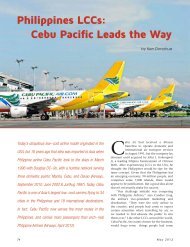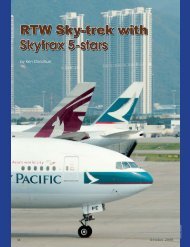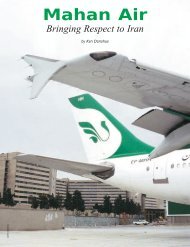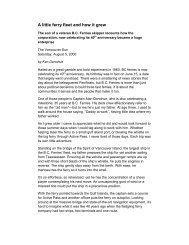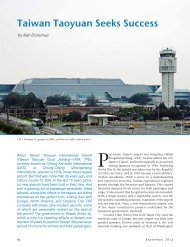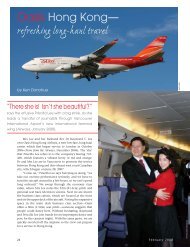Philippine Airlines: Asia's First, Striving to Shine - Ken Donohue
Philippine Airlines: Asia's First, Striving to Shine - Ken Donohue
Philippine Airlines: Asia's First, Striving to Shine - Ken Donohue
You also want an ePaper? Increase the reach of your titles
YUMPU automatically turns print PDFs into web optimized ePapers that Google loves.
efficient, and allows us <strong>to</strong> fly across the Pacific, with<br />
less maintenance than with the 747s we currently fly <strong>to</strong><br />
Los Angeles and San Francisco,” acknowledges Bautista.<br />
“While the Triple-Seven has less passenger capacity, it<br />
has huge cargo capacity.”<br />
In time, the 777s will replace the 747s. PAL would<br />
like <strong>to</strong> operate the 777 <strong>to</strong> the USA, but is prevented by<br />
the US Federal Aviation Administration’s downgrading<br />
of the safety oversight rating for the <strong>Philippine</strong>s Civil<br />
Aviation Authority from Category 1 <strong>to</strong> 2 in 2008. This<br />
means no <strong>Philippine</strong> airline is able <strong>to</strong> add routes, or<br />
operate new aircraft on existing services <strong>to</strong> the United<br />
States. As a result, PAL continues <strong>to</strong> operate the Airbus<br />
A340 on its four times-weekly flights <strong>to</strong> Las Vegas (via<br />
Vancouver), while the 777 is used on days when the<br />
flight terminates in Canada.<br />
Making matters worse, the European Union<br />
followed the FAA’s lead and announced similar<br />
sanctions in 2010. “We are being penalized for the<br />
inefficiencies of the government. We want <strong>to</strong> serve<br />
new destinations, especially in the US,” declares an<br />
exasperated Bautista. “With three million Filipinos<br />
living in the United States, we’d like <strong>to</strong> initiate service<br />
<strong>to</strong> New York, Chicago, and Seattle. The government<br />
is fully aware of the consequences <strong>to</strong> the airline.”<br />
Bautista reveals that <strong>Philippine</strong> <strong>Airlines</strong> would like <strong>to</strong><br />
restart service <strong>to</strong> Europe, but with much more modest<br />
ambitions than in the past. PAL is interested in serving<br />
Frankfurt or Munich, and then entering in<strong>to</strong> codeshare<br />
agreements <strong>to</strong> transfer passengers throughout the<br />
continent. All of this is, of course, dependent on the<br />
country regaining its Category 1 status.<br />
The <strong>Philippine</strong> diaspora is estimated at more than<br />
ten million, with the USA, Saudi Arabia, Malaysia,<br />
Canada, and the United Arab Emirates representing<br />
the <strong>to</strong>p five countries where Filipinos reside overseas.<br />
“Ninety percent of our passengers are Filipinos,”<br />
Bautista concedes. “They like <strong>to</strong> fly PAL because they<br />
feel as if they are in the <strong>Philippine</strong>s the minute they<br />
step on our aircraft. Our cabin crews speak their<br />
language [Tagalog], and we offer Filipino cuisine on all<br />
our flights.” While this provides a natural market for<br />
the airline, PAL would also like <strong>to</strong> attract more visi<strong>to</strong>rs<br />
<strong>to</strong> the country <strong>to</strong> support the <strong>to</strong>urism industry.<br />
Bautista thinks it unlikely that the airline will<br />
resume flights <strong>to</strong> the Middle East, despite close <strong>to</strong><br />
1.5 million Filipinos working in the region. “It’s very<br />
difficult, Middle Eastern carriers operate almost 70<br />
flights a week in<strong>to</strong> Manila, and we just can’t compete<br />
with that kind of capacity.” While Bautista sounds<br />
defeated, it’s a positive sign that the airline is making<br />
sound business decisions about the markets it serves,<br />
rather than simply operating a route because it thinks<br />
it should.<br />
On both domestic and regional routes, <strong>Philippine</strong><br />
<strong>Airlines</strong> faces stiff competition from low-cost carriers.<br />
In fact, in 2010 Cebu Pacific (Airways, June 2002)<br />
surpassed the flag carrier as the the country’s largest<br />
airline as rated by domestic traffic. PAL’s strategy <strong>to</strong><br />
compete is <strong>to</strong> have partner Airphil Express operate<br />
nine routes on its behalf. Previously known as Air<br />
<strong>Philippine</strong>s, that financially troubled airline was taken<br />
over by the same inves<strong>to</strong>r group that owns PAL, but has<br />
a separate management group.<br />
PAL<br />
Economy class of a PAL Boeing 777.<br />
A i r w a y s<br />
29


